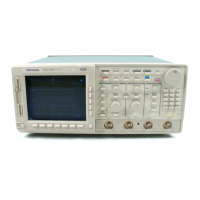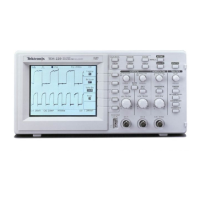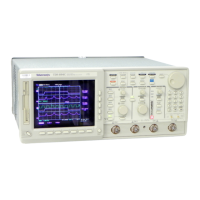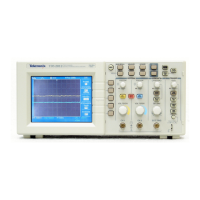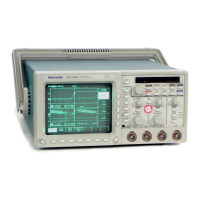Appendix B: Algorithms
TDS 684A, TDS 744A, & TDS 784A User Manual
B–3
The oscilloscope also measures several values itself that it uses to help calculate
measurements.
RecordLength — is the number of data points in the time base. You set it with
the Horizontal menu Record Length item.
Start — is the location of the start of the measurement zone (X-value). It is 0.0
samples unless you are making a gated measurement. When you use gated
measurements, it is the location of the left vertical cursor.
End — is the location of the end of the measurement zone (X-value). It is
( – 1.0) samples unless you are making a gated measurement.
When you use gated measurements, it is the location of the right vertical cursor.
Hysteresis — The hysteresis band is 10% of the waveform amplitude. It is used
in , , and calculations.
For example, once a crossing has been measured in a negative direction, the
waveform data must fall below 10% of the amplitude from the point
before the measurement system is armed and ready for a positive crossing.
Similarly, after a positive crossing, waveform data must go above 10%
of the amplitude before a negative crossing can be measured. Hysteresis is useful
when you are measuring noisy signals, because it allows the oscilloscope to
ignore minor fluctuations in the signal.
MCross1, MCross2, and MCross3 — refer to the first, second, and third
cross times, respectively. (See Figure B–1.)
The polarity of the crossings does not matter for these variables, but the
crossings alternate in polarity; that is, could be a positive or negative
crossing, but if is a positive crossing, will be a negative
crossing.
The oscilloscope calculates these values as follows:
1. Find the first in the waveform record or the gated region.
This is .
2. Continuing from , find the next in the waveform
record (or the gated region) of the opposite polarity of . This is
.
3. Continuing from , find the next in the waveform
record (or the gated region) of the same polarity as . This is
.
Other Variables
MCross Calculations

